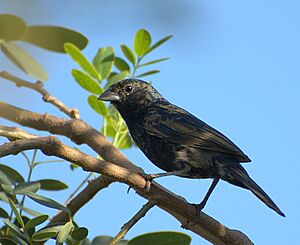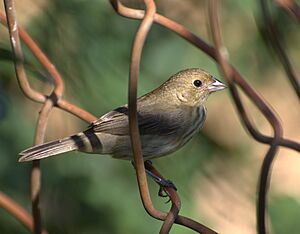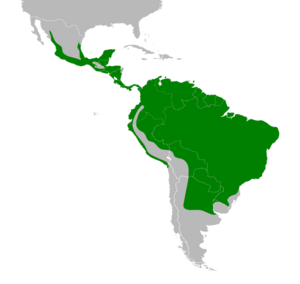Blue-black grassquit facts for kids
Quick facts for kids Blue-black grassquit |
|
|---|---|
 |
|
| male at Manduri, São Paulo State, Brazil | |
 |
|
| female at Manduri, São Paulo State, Brazil | |
| Conservation status | |
| Scientific classification | |
 |
|
| Synonyms | |
|
Tanagra jacarina Linnaeus, 1766 |
The blue-black grassquit (Volatinia jacarina) is a small bird that lives in warm parts of the Americas. It belongs to the tanager family, called Thraupidae. This bird is found from southern Mexico, through Central America, and all the way down to northern Chile and Argentina. You can also find it in Trinidad and Tobago. It's the only bird in its group, called Volatinia.
Male and female blue-black grassquits look different. The male is a shiny blue-black color. It has some white under its wings. The female is brown on top. Her belly is a light tan color with darker stripes.
Contents
About the Blue-Black Grassquit
How it Got its Name
The blue-black grassquit was first described in 1766. A Swedish scientist named Carl Linnaeus gave it the name Tanagra jacarina. He wrote about it in his book Systema Naturae. The name jacarina comes from the Tupi language. It was used for a type of finch.
Later, in 1850, another scientist named Ludwig Reichenbach put this bird into its own group. This group is called Volatinia. The name Volatinia means "flying" in Latin. Today, the blue-black grassquit is the only bird in the Volatinia group.
Different Types of Grassquits
There are three main types, or subspecies, of the blue-black grassquit:
- V. j. splendens: Found from Mexico to Colombia. It also lives in Venezuela, the Guianas, and the Amazon area. You can see it in Trinidad, Tobago, and Grenada too.
- V. j. jacarina: Lives from southeast Peru to eastern Brazil. It goes south into northern Argentina.
- V. j. peruviensis: Found in western Ecuador, western Peru, and northwest Chile.
What it Looks Like
Adult blue-black grassquits are about 10.2 cm (4.0 in) long. They weigh around 9.3 g (0.33 oz). They have a thin, pointed black beak.
As mentioned, the male is a shiny blue-black. Its tail and wings are black. When it flies, you can see the white part under its wings. Female and young birds are brown on their backs. Their undersides are light tan with dark streaks.
How it Behaves
Daily Life and Diet
Blue-black grassquits often live in pairs. They sometimes have other partners or lay eggs in other nests. During the time they raise their young, males protect a small area. This area is about 13 to 72 square meters. Lighter males are usually stronger in these areas.
When they are not raising young, these birds often gather in flocks. They mostly eat seeds. They find most of their food on the ground.
The "Johnny Jump-Up" Display
Males have a special "jumping" display. They often do this for a long time. This is why some people call them "johnny jump-up." While jumping, they make a wheezing jweeee sound. They can jump many times in just one minute.
This fancy display can also be risky. It can attract predators, which are animals that hunt them. Because of this, nests are more likely to be attacked. Sounds from predators can even make these birds feel stressed.
Nests
Blue-black grassquits build small cup-shaped nests. They use tiny roots to make them. These nests are about 7.5 cm wide. They are usually found in grassy areas. The nests are placed about 10 to 50 cm off the ground. Both the male and female birds help build the nest.


